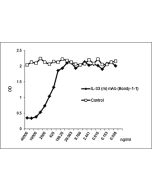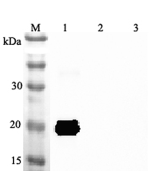Cookie Policy: This site uses cookies to improve your experience. You can find out more about our use of cookies in our Privacy Policy. By continuing to browse this site you agree to our use of cookies.
AdipoGen Life Sciences
anti-IL-33 (mouse), mAb (rec.) (blocking) (Bondy-1-1)

Methods: IL-33 (mouse) was coated on an ELISA plate at 1μg/ml. IL-33 (mouse), mAb (rec.) (blocking) (Bondy-1-1) (AG-27B-0013) or an unrelated mAb (recombinant) (Control) were added (starting at 40μg/ml with a twofold serial dilution) together with 100μl of supernatant of cells containing ST2 (human):Fc/IL-1RAcP (human):Fc. After incubation for 1h at RT, the binding was detected using an anti-Fc human antibody (HRP).
| Product Details | |
|---|---|
| Synonyms | Interleukin-33; IL-1F11; NF-HEV |
| Product Type | Recombinant Antibody |
| Properties | |
| Clone | Bondy-1-1 |
| Isotype | Mouse IgG2b |
| Source/Host | Produced without the use of animals. Purified from HEK 293 cell culture supernatant. |
| Immunogen/Antigen | Mouse recombinant IL-33. |
| Application |
ELISA |
| Crossreactivity | Mouse |
| Specificity |
Recognizes mouse IL-33. |
| Purity | ≥95% (SDS-PAGE) |
| Purity Detail | Protein A-affinity purified. |
| Endotoxin Content | <0.01EU/μg purified protein (LAL test; Lonza). |
| Concentration | 1mg/ml |
| Formulation | Liquid. In PBS containing 10% glycerol and 0.02% sodium azide. |
| Isotype Negative Control | |
| Other Product Data |
anti-IL-33 (mouse), monoclonal antibody (recombinant) (Bondy-1-1) is composed of human variable regions (VH and VL) (λ-chain) of immunoglobulin fused to the mouse lgG2b Fc domain. |
| Shipping and Handling | |
| Shipping | BLUE ICE |
| Short Term Storage | +4°C |
| Long Term Storage | -20°C |
| Handling Advice |
After opening, prepare aliquots and store at -20°C. Avoid freeze/thaw cycles. |
| Use/Stability | Stable for at least 1 year after receipt when stored at -20°C. |
| Documents | |
| MSDS |
 Download PDF Download PDF |
| Product Specification Sheet | |
| Datasheet |
 Download PDF Download PDF |
Interleukin-33 (IL-33; HF-NEV; IL-1F11), a member of the IL-1 family of cytokines, is expressed by many cell types following pro-inflammatory stimulation and is thought to be released upon cell lysis. IL-33 binds to and signals through ST2 (IL-1R1) and its stimulation recruits MYD88, IRAK, IRAK4 and TRAF6, followed by phosphorylation of ERK1 (MAPK3)/ERK2 (MAPK1), p38 (MAPK14) and JNK. The ability of IL-33 to target numerous immune cell types, like Th2-like cells, mast cells and B1 cells, and to induce cytokine and chemokine production underlines its potential in influencing the outcome of a wide range of diseases, such as arthritis, asthma, atopic allergy & anaphylaxis, cardiovascular disease/atherosclerosis, nervous system diseases and sepsis.
Anti-IL-33, mAb (recombinant) (blocking) (Bondy-1-1) is an antibody developed by antibody phage display technology using a human naive antibody gene library. These libraries consist of scFv (single chain fragment variable) composed of VH (variable domain of the human immunoglobulin heavy chain) and VL (variable domain of the human immunoglobulin light chain) connected by a polypeptide linker. The antibody fragments are displayed on the surface of filamentous bacteriophage (M13). This scFv was selected by affinity selection on antigen in a process termed panning. Multiple rounds of panning are performed to enrich for antigen-specific scFv-phage. Monoclonal antibodies are subsequently identified by screening after each round of selection. The selected monoclonal scFv is cloned into an appropriate vector containing a Fc portion of interest and then produced in mammalian cells to generate an IgG like scFv-Fc fusion protein.
- Regulation of de novo adipocyte differentiation through crosstalk between adipocytes and pre-adipocytes: T.D. Challa, et al.; Diabetes 64, 4075 (2015)
- Male-specific IL-33 expression regulates sex-dimorphic EAE susceptibility: A.E. Russi, et al.; PNAS 115, E1520 (2018) (In vivo Application)










